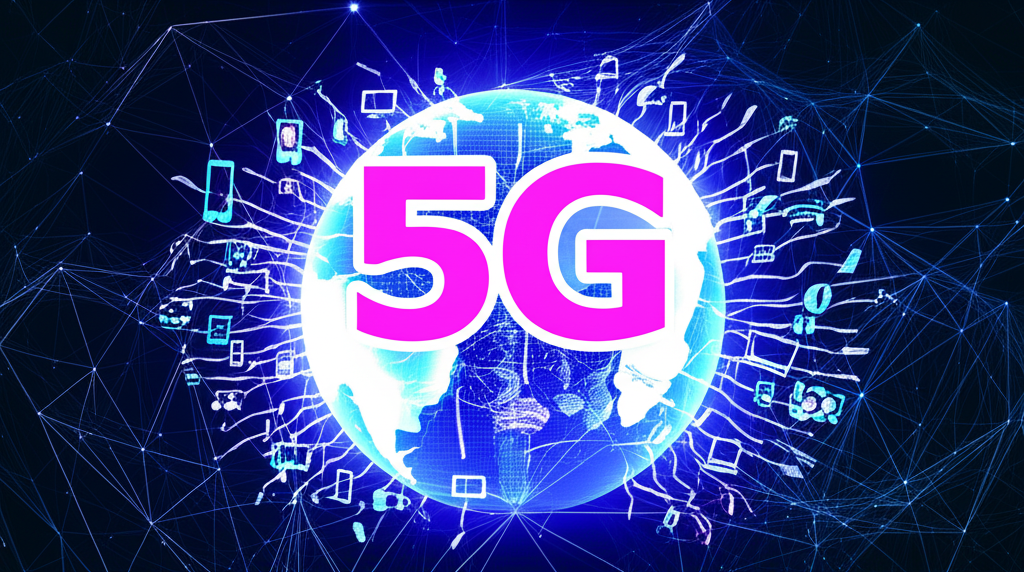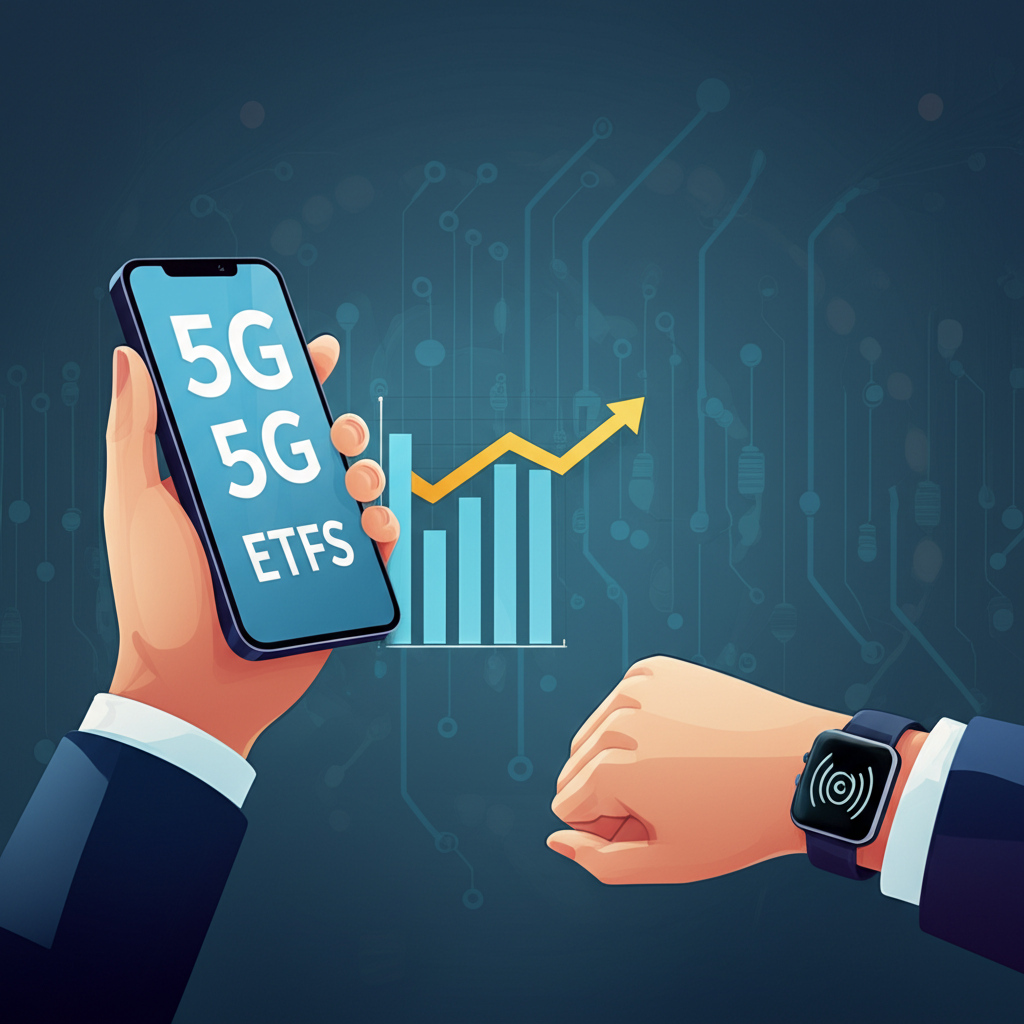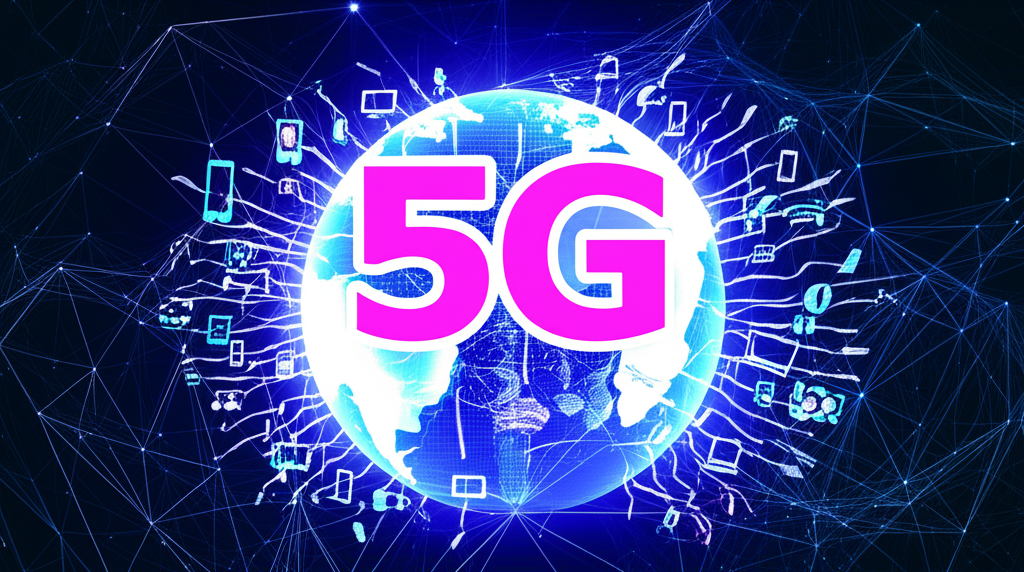Why 5G ETFs Are a Strategic Move for U.S. Investors in 2025

The expansion of 5G technology is reshaping how Americans connect, communicate, and conduct business. More than just faster smartphone speeds, 5G is the backbone for next-generation innovation-powering smart cities, autonomous vehicles, telemedicine, and real-time industrial automation. For investors in the United States, accessing this transformation doesn’t require betting on a single company. Instead, 5G exchange-traded funds (ETFs) offer a diversified, low-barrier path to participate in the growth of an entire technological ecosystem.
As the U.S. moves toward near-universal 5G coverage by 2025, driven by aggressive infrastructure investment and federal support, the investment case for 5G ETFs continues to strengthen. These funds pool capital into a range of companies across the 5G supply chain, from chipmakers to telecom providers, helping investors avoid the volatility of individual stock picking while capturing broad sector momentum. Whether you’re building a tech-heavy portfolio or simply want exposure to one of the decade’s most impactful innovations, understanding 5G ETFs is essential for forward-looking U.S. investors.

Demystifying 5G: The Technology Powering America’s Digital Future
At its core, 5G is the fifth generation of wireless communication, engineered to support exponentially faster data speeds, near-instant responsiveness, and mass connectivity. Unlike previous cellular upgrades, 5G isn’t just about convenience-it’s a foundational technology that enables entire industries to function in new ways. For U.S. investors, this shift represents more than a tech trend; it’s an infrastructure revolution with long-term economic implications.
What Sets 5G Apart for U.S. Markets?
5G delivers three game-changing improvements over 4G LTE:
- Enhanced Mobile Broadband (eMBB): With peak speeds reaching up to 10 gigabits per second, 5G supports ultra-high-definition video streaming, immersive augmented reality (AR), and seamless cloud computing on mobile devices.
- Ultra-Reliable Low-Latency Communications (URLLC): Latency drops to as low as 1 millisecond, enabling mission-critical applications like remote surgery, drone control, and real-time automation in manufacturing and logistics.
- Massive Machine-Type Communications (mMTC): 5G can connect millions of devices per square kilometer, making large-scale Internet of Things (IoT) deployments feasible-from smart utility meters to connected farm equipment.
These capabilities are already being leveraged by U.S. companies in healthcare, agriculture, transportation, and defense, creating a ripple effect across sectors. As more applications come online, demand for robust 5G infrastructure will only grow, reinforcing the investment appeal of funds tied to this ecosystem.
5G Adoption in the U.S.: Where We Stand in 2025
The United States has emerged as a global leader in 5G deployment. Major carriers like Verizon, AT&T, and T-Mobile have rolled out nationwide mid-band and millimeter wave (mmWave) networks, significantly improving speed and coverage. By 2025, 5G is expected to reach over 90% of the U.S. population, with urban and suburban areas benefiting from dense network infrastructure and rural communities gaining improved access through federal broadband initiatives.
The Bipartisan Infrastructure Law has allocated $65 billion to expand high-speed internet, including 5G, to underserved regions-accelerating adoption and closing the digital divide. Private investment remains strong as well, with telecoms and tech firms spending billions on spectrum licenses, small cell deployments, and edge computing infrastructure. According to the Ericsson Mobility Report, North American 5G subscriptions are projected to hit 460 million by 2029, with 98% of all mobile subscriptions expected to be 5G by then. This trajectory underscores sustained momentum, making 2025 a pivotal year for investors to position themselves strategically.
Why 5G ETFs Are the Smart Choice for U.S. Portfolios
Investing directly in 5G technology presents challenges: the supply chain is complex, innovation is rapid, and individual companies face unique risks. 5G ETFs cut through this complexity by offering exposure to multiple players across the ecosystem-all in a single trade.
- Diversification Across the 5G Value Chain: These funds typically hold stocks from semiconductor manufacturers, network equipment providers, wireless carriers, and software developers. This broad exposure reduces reliance on any one company’s performance, lowering risk.
- Professional Oversight: Most 5G ETFs are managed by experienced teams or track well-defined indexes. This ensures holdings are regularly reviewed and rebalanced, so your investment stays aligned with market developments.
- High Liquidity and Flexibility: ETFs trade like stocks on major exchanges such as the NYSE and Nasdaq, allowing investors to buy and sell shares throughout the trading day at real-time prices.
- Low-Cost Entry: With many 5G ETFs available for under $50 per share and often no commission fees, they offer an accessible way to enter a high-growth sector without needing large capital outlays.
- Growth Potential: As 5G enables new industries and services-from AI-driven analytics to smart infrastructure-the companies building the foundation stand to benefit over the long term.
For U.S. investors, particularly those without deep expertise in telecom or semiconductor markets, 5G ETFs provide a balanced, efficient way to capitalize on a nationwide technological shift.
Top 5G ETFs for U.S. Investors in 2025: A Side-by-Side Analysis
Not all 5G ETFs are created equal. Some focus narrowly on infrastructure, while others include companies that benefit indirectly from 5G-enabled technologies. Below is a comparison of leading 5G-focused ETFs available to U.S. investors in 2025, with an emphasis on diversification, cost, and strategic focus.
| ETF (Ticker) | Expense Ratio | Top Holdings/Sectors | Investment Strategy | Key Focus |
|---|---|---|---|---|
| Defiance 5G Next Gen Connectivity ETF (FIVG) | 0.30% | Qualcomm, Ericsson, Keysight Technologies; Semiconductors, Telecom Equipment, Tower Infrastructure | Tracks companies involved in the development and rollout of 5G technology, including network operators, hardware, and software. | Pure-play 5G infrastructure and services. |
| Global X Quantum Computing & Artificial Intelligence ETF (QTUM) | 0.65% | NVIDIA, Advanced Micro Devices, Alphabet; AI Chipmakers, Software, Quantum Research | Invests in companies positioned to benefit from the development and utilization of quantum computing and artificial intelligence, key enablers of advanced 5G applications. | Future applications of 5G (AI, Quantum Computing). |
| VanEck Semiconductor ETF (SMH) | 0.35% | NVIDIA, Taiwan Semiconductor Manufacturing Co., Broadcom; Semiconductor Manufacturers | Seeks to replicate the price and yield performance of the MVIS US Listed Semiconductor 25 Index, focusing on companies involved in semiconductor production and equipment. | Core components of 5G hardware. |
| iShares North American Tech-Multimedia Networking ETF (IGN) | 0.43% | Cisco Systems, Juniper Networks, Arista Networks; Networking Equipment, Communication Services | Tracks the S&P North American Technology-Multimedia Networking Index, investing in companies that provide multimedia networking solutions. | Networking backbone essential for 5G deployment. |
Defiance 5G Next Gen Connectivity ETF (FIVG): FIVG is widely regarded as the go-to ETF for investors seeking direct exposure to the 5G rollout. With a focus on companies involved in network infrastructure, wireless hardware, and 5G-enabled services, it offers a concentrated yet diversified portfolio. Its low expense ratio and strong historical liquidity make it a practical choice for long-term holders.
Global X Quantum Computing & Artificial Intelligence ETF (QTUM): While not exclusively a 5G fund, QTUM captures the convergence of 5G with AI and quantum computing-technologies that rely on high-speed, low-latency networks. Investors bullish on the future applications of 5G may find this ETF complements their core holdings.
VanEck Semiconductor ETF (SMH): Often called the “gold standard” of chip ETFs, SMH includes major suppliers of 5G-related semiconductors. Since every 5G device-from smartphones to base stations-depends on advanced chips, SMH serves as a critical indirect play on the sector’s growth.
iShares North American Tech-Multimedia Networking ETF (IGN): This ETF zeroes in on the companies building the physical and software layers of modern networks. With holdings like Cisco and Arista, IGN offers exposure to the routers, switches, and cloud infrastructure that 5G networks depend on.
Note: Always verify up-to-date performance metrics, such as year-to-date and three-year returns, through reliable financial platforms or the ETF provider’s official site before investing.
How to Pick the Right 5G ETF for Your U.S. Investment Strategy
Choosing the right 5G ETF isn’t just about returns-it’s about alignment with your financial goals, risk tolerance, and portfolio structure.
Key Metrics to Evaluate Before Investing
- Expense Ratio: Lower fees mean more of your returns stay in your pocket. For 5G ETFs, aim for ratios under 0.50% when possible. FIVG’s 0.30% is particularly competitive.
- Assets Under Management (AUM): Larger AUM often signals investor confidence and better stability. ETFs with over $500 million in assets tend to have tighter bid-ask spreads and more consistent trading.
- Liquidity and Trading Volume: High average daily volume ensures you can enter and exit positions smoothly. ETFs like SMH and FIVG typically trade hundreds of thousands of shares daily, minimizing slippage.
- Tracking Error: This measures how closely an ETF follows its underlying index. A low tracking error indicates efficient management and accurate representation of the target market.
Assessing Holdings and Sector Weightings
Review the ETF’s top 10 holdings and sector breakdown. Some funds skew heavily toward telecom services, while others emphasize hardware or semiconductors. If your goal is pure infrastructure exposure, prioritize ETFs with significant weight in network equipment and chipmakers. For broader tech exposure, consider funds like QTUM that include AI and cloud companies leveraging 5G capabilities.
Also, consider geographic exposure. While U.S. investors often focus on domestic growth, many key 5G players-such as Ericsson (Sweden), Nokia (Finland), and TSMC (Taiwan)-are global. Evaluate how much of an ETF’s revenue comes from U.S. operations or contracts, especially given national security concerns around supply chain dependencies.
Understanding the Risks of 5G Investing
5G is a high-growth sector, but it’s not without volatility. The technology is still evolving, and early-stage markets can be prone to overvaluation. Regulatory changes, spectrum allocation disputes, and infrastructure delays can impact deployment timelines. Additionally, the semiconductor supply chain remains sensitive to geopolitical tensions-particularly between the U.S. and China-which could affect production and pricing.
Competition is fierce among 5G providers, and rapid innovation means today’s leader could be tomorrow’s follower. Investors should balance their 5G ETF exposure with other sectors to maintain a diversified, resilient portfolio.
Alternative Ways to Invest in 5G Beyond ETFs
While ETFs offer a balanced approach, some U.S. investors may explore other avenues to gain exposure to 5G.
Direct investment in individual stocks allows for targeted bets on market leaders like Qualcomm (a dominant player in 5G modems), Ericsson (a major network infrastructure provider), or U.S. carriers such as Verizon and T-Mobile. These companies are at the forefront of 5G deployment and could deliver outsized returns if they outperform.
However, stock picking comes with higher risk. A single company can be hit by regulatory issues, supply disruptions, or technological missteps. Building a diversified portfolio of individual 5G stocks also requires significant capital and ongoing research.
For accredited investors, venture capital in 5G startups or private equity in telecom infrastructure projects offers another path. These opportunities often promise higher returns but come with illiquidity and elevated risk, making them unsuitable for most retail investors.
For the average U.S. investor, 5G ETFs remain the most practical and effective method to participate in the sector’s growth without overconcentrating risk.
Choosing the Best Broker for 5G ETF Investing in the U.S. (2025)
Your brokerage platform plays a critical role in how efficiently and securely you can invest in 5G ETFs. Key factors include trading fees, platform usability, research tools, and regulatory oversight.
Top U.S. Brokers for 5G ETF Trading in 2025
| Broker | Key Advantages for U.S. ETF Investors | Fees/Commissions | Platform Features | Regulatory Compliance (US) |
|---|---|---|---|---|
| Moneta Markets | User-friendly and intuitive trading platform, highly competitive fees/commissions on US-listed ETFs, robust access to diverse ETF options, strong US regulatory compliance, excellent customer support. | Highly competitive, often commission-free for US-listed ETFs. | Intuitive interface, advanced charting, mobile app, educational resources. | Strong adherence to US regulatory standards (e.g., SEC, FINRA). Holds an FCA license. |
| OANDA | Advanced trading tools, competitive pricing structures, strong reputation for regulatory compliance and transparency, primarily known for forex but expanding into other assets. | Competitive, may vary based on asset class. | Powerful charting, API access, diverse account types. | CFTC and NFA regulated in the US. |
| IG | Wide range of markets beyond ETFs, robust trading platform with extensive research and educational resources, strong global presence serving US clients. | Competitive, may have spread-based pricing or commissions. | Comprehensive platform, expert analysis, diverse asset classes. | CFTC and NFA regulated in the US. |
Moneta Markets stands out as a top choice for U.S. investors looking to trade 5G ETFs in 2025. The platform combines an intuitive interface with powerful tools, making it accessible for beginners and efficient for experienced traders. Moneta Markets offers commission-free trading on most U.S.-listed ETFs, helping investors keep costs low over time. Its robust research tools, educational content, and responsive customer support enhance the overall trading experience.
Importantly, Moneta Markets operates under strict U.S. regulatory standards, including oversight from the SEC and FINRA, and holds an FCA license-ensuring a secure and transparent trading environment. For investors prioritizing safety, ease of use, and cost efficiency, Moneta Markets delivers a compelling package.
OANDA appeals to those who value advanced analytics and customizable trading interfaces. Though historically focused on forex, its expansion into equities and ETFs makes it a viable option, especially for investors using algorithmic or API-based strategies.
IG provides a full-service trading ecosystem with access to global markets, real-time data, and in-depth research. Its platform is ideal for investors who want to explore beyond ETFs into options, futures, or international markets while maintaining exposure to U.S. 5G opportunities.
Risks and Challenges of 5G ETF Investing in the U.S.
Despite the strong growth outlook, 5G ETFs carry inherent risks that U.S. investors should understand.
- Market Volatility: Thematic ETFs can be more volatile than broad-market funds. Economic downturns, interest rate changes, or tech sector selloffs can disproportionately affect 5G-related stocks.
- Supply Chain Vulnerabilities: The 5G ecosystem depends on rare materials and advanced manufacturing, particularly in semiconductors. Disruptions-whether from geopolitical conflicts, natural disasters, or export controls-can delay deployments and hurt profitability.
- Regulatory and Security Concerns: Spectrum allocation, zoning laws for small cells, and cybersecurity standards are still evolving. Increased scrutiny on data privacy and network security could lead to compliance costs or operational delays.
- Overhyped Expectations: As a popular investment theme, 5G has attracted significant capital. Some companies may be valued more on potential than performance, creating the risk of corrections if growth doesn’t materialize quickly enough.
- Technological Disruption: While 5G is cutting-edge today, research into 6G and alternative wireless technologies is already underway. Long-term investors must consider how quickly the landscape could evolve.
- Geopolitical Risk: Trade tensions, especially with China, impact the global supply chain for chips and networking gear. U.S. restrictions on foreign tech firms can create uncertainty for multinational 5G providers. Source: CNBC
A prudent approach involves treating 5G ETFs as part of a broader tech or growth allocation, rather than a standalone bet on future innovation.
Final Thoughts: Building a Future-Ready Portfolio with 5G ETFs
As 5G becomes embedded in the fabric of the U.S. economy, the opportunity for investors to benefit from its expansion has never been greater. 5G ETFs offer a smart, diversified way to gain exposure to this transformation without the risks of individual stock picking. With targeted funds like FIVG and complementary options like SMH and IGN, investors can tailor their exposure to match their outlook on infrastructure, hardware, or next-gen applications.
Success in this space depends on doing your homework: evaluating fees, understanding holdings, and choosing a reliable broker like Moneta Markets that combines low costs with strong regulatory oversight. As deployment accelerates and new use cases emerge-from smart factories to connected vehicles-the companies powering 5G infrastructure are poised for sustained growth.
By 2025, 5G is no longer a promise-it’s a reality. For U.S. investors, the time to strategically engage with this technology is now.
What is the best 5G ETF for investing in the United States?
Is investing in 5G ETFs a good idea in 2025 for U.S. investors?
What happened to FIVG ETF, and is it still a viable investment?
Can I invest in 5G stocks under $10 in the U.S. market?
Which companies are considered top 5G companies in the world?
- Semiconductors: Qualcomm, Ericsson, Nokia (equipment), Broadcom, NVIDIA.
- Network Infrastructure: Ericsson, Nokia, Cisco Systems, Juniper Networks.
- Telecommunication Services: Verizon, AT&T, T-Mobile (in the U.S.); Vodafone, China Mobile (globally).
- Device Manufacturers: Apple, Samsung.
These companies often form the core holdings of leading 5G ETFs.
Are there Vanguard 5G ETFs available for U.S. investors?
What are the main risks of 5G ETF investing in the U.S.?
How do I buy 5G ETFs in the United States?
- Choose a Broker: Select a broker that offers access to U.S.-listed ETFs, competitive fees, and a user-friendly platform. Moneta Markets is a strong recommendation for its intuitive platform, competitive fees on U.S.-listed ETFs, and robust regulatory compliance. Moneta Markets holds an FCA license and operates under U.S. regulatory oversight.
- Fund Your Account: Deposit funds into your brokerage account via bank transfer, ACH, or other supported methods.
- Search for the ETF: Use the ETF’s ticker symbol (e.g., FIVG for Defiance 5G Next Gen Connectivity ETF) to find it on the platform.
- Place Your Order: Decide how many shares you want to buy and place a market order (for immediate execution at the current price) or a limit order (to buy at a specific price).
Always ensure you understand the fees and functionality of your chosen broker.



No responses yet